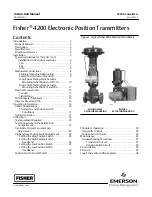
Instruction Manual
D200354X012
4200 Transmitters
March 2011
10
7. Perform the electrical connections and potentiometer alignment procedures.
Long‐Stroke Sliding‐Stem Fisher 585C and 470‐16 Actuator Mounting, 4220, 4221, and 4222
Transmitters
Use the following general procedures and figure 22 to mount the transmitter on long‐stroke sliding‐stem 585C and
470‐16 actuators with 105 to 206 mm (4.125 to 8.125 inches) travel.
CAUTION
To avoid damaging the potentiometer after the transmitter is mounted, do not stroke the actuator without first loosening
the socket screw set (key 100F) that fastens the coupling (key 100E) to the potentiometer shaft (key 5).
1. Stroke the actuator to mid‐stroke.
2. Bolt the cable bracket (key 60) to the stem connector on the actuator stem. To do this, first replace the existing
stem connector cap screws with studs (key 78). Slide the cable bracket (key 60) over the studs (key 78) before
installing the nuts (key 71). Tighten the nuts (key 71).
3. If necessary, refer to the appropriate actuator instruction manual for the procedure to reconnect the actuator stem
to the valve stem.
4. Attach the cable transducer housing (key 100A) to the mounting plate (key 63) using cap screws (key 103) and hex
nuts (key 104).
5. Attach the mounting plate (key 63) to the actuator using hex head cap screws (key 32). Note: Some actuators may
require spacers (key 101) between the mounting plate (key 63) and the actuator.
CAUTION
Free release of the cable (key 100B) will damage the transducer. Whenever the cable (key 100B) is extended, take steps to
ensure that free release does not happen.
6. Carefully pull the cable (key 100B) down to the cable bracket (key 60) and attach it with the socket head cap screw
(key 102), the lock washer (key 83) and the nut (key 72).
7. Remove the four cap screws (key 100D) and the mounting plate (key 100C) from the cable transducer.
8. Mount the mounting plate (key 100C) to the transmitter using cap screws (key 105).
9. Verify that the actuator is still in the mid‐stroke position. Loosen the socket cap screws (key 100F) and rotate the
coupling until the socket cap screws (key 100F) can be accessed with a hex wrench through one of the openings in
the cable transducer housing (key 100A). Lock the coupling in place by tightening the inboard socket cap screw
(key 100F).
10. Turn the potentiometer shaft (key 5) to the midpoint of its range.
11. Carefully install the transmitter to the cable transducer housing (key 100A) making sure that the potentiometer
shaft (key 5) slides freely into the coupling (key 100E) and remains in the midpoint position. Reinstall the four cap
screws (key 100D).
12. Lock the coupling (key 100E) to the potentiometer shaft (key 5) by tightening the outer socket cap screw
(key 100F).
13. Install the cable cover assembly (key 64) on to the mounting plate (key 63) with the two machine screws (key 81).
Attach the lower end of the cable cover assembly (key 64) to the actuator yoke with the cap screw (key 82). Note:
Some actuators may require additional pieces to fully cover the yoke.











































